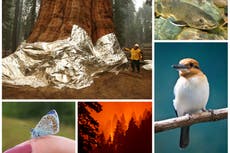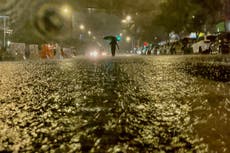Congressman forced to flee flooding on trip to assess flooding
The Flagstaff area has faced serious flooding this year as summer rains hit recently burned areas, which can be prone to flash floods


Arizona Congressman Tom O’Halleran was in Flagstaff on Wednesday to see areas that have been hit hard by recent flooding.
Little did he know he would get a up-close and personal look at the issue.
The congressman, a local flood manager and a group of federal officials were driving around areas that have borne the brunt of the floods when a storm hit and the group had to look for higher ground, the Arizona Republic reports.
As they drove, waters rolled down the road with them as they avoided getting stuck in the oncoming waters, the paper says.
"They got to experience it," Lucinda Andreani, the local flood manager told the Republic. "It was a very dramatic experience for all of them."
Areas around Flagstaff have flooded repeatedly this summer as the annual monsoon rains hit the southwest US.
But those rains have turned into worse flooding by recent wildfires in the region. After wildfire scorches a landscape, there’s no longer vegetation to disperse or absorb the rain.
Fires can also leave a layer of soil that doesn’t absorb a lot of water — so when heavy rainfall hits the burn scar it can quickly turn into a flash flood.
Earlier in the summer, the Pipeline Fire and the Tunnel Fire both burned north of Flagstaff. The Pipeline Fire covered 41 square miles (107 square kilometres) just north of the city and areas downhill of the burn scar have flooded this summer.
Flooding dangers from wildfire burn scars can last for years. Parts of the Flagstaff area downhill from the Museum Fire, which hit in 2019, have also flooded this year.
In the neighbourhoods that flooded again on Wednesday, about 1,500 homes are at risk, the Republic reports.
At least 31 Flagstaff homes have been damaged by floods this year, reports Arizona’s Family. A water line in the city has also been damaged by flooding from the Pipeline Fire burn scar, according to the Arizona Daily Sun.
The southwest’s rainy season usually lasts between mid-June and mid-September and can often bring flash floods to the area’s low-lying areas, especially in canyons.
The National Weather Service (NWS) has issued a flood watch for most of Arizona and New Mexico as rains continue. In Flagstaff, NWS has warned that storms and flash floods could continue into next week, with possible rainfall coming at one or two inches per hour.
But the risk of flash flooding is also likely to increase as the climate crisis grows.
For one, the risk of wildfire is growing, especially out west. While these rains may bring a lot of water, most of the western US is in the midst of a serious drought.
All of Arizona is currently seeing drier conditions than usual, with a third of the state facing “severe drought”, according to the US government’s drought monitor.
The whole southwest is also in the midst of a decades-long “megadrought” — the driest two-decade period in at least 1,200 years — that has been fuelled by the climate crisis.
Drought is likely to get worse in the US southwest as the climate crisis gets worse. And with all that drought comes a much higher risk of wildfires catching and spreading rapidly — as well as the subsequent flooding over those burned landscapes.
But flash floods could increase for another reason, too. In a warmer climate, storms will dump a lot more water over an area in a short period of time — leading to a much higher risk of flash flooding, a recent paper found.
Join our commenting forum
Join thought-provoking conversations, follow other Independent readers and see their replies
Comments


Bookmark popover
Removed from bookmarks